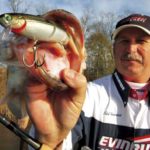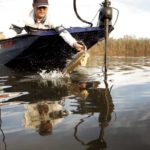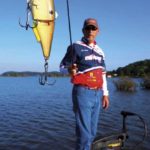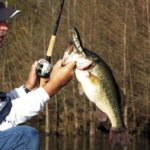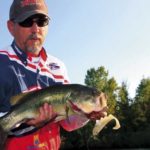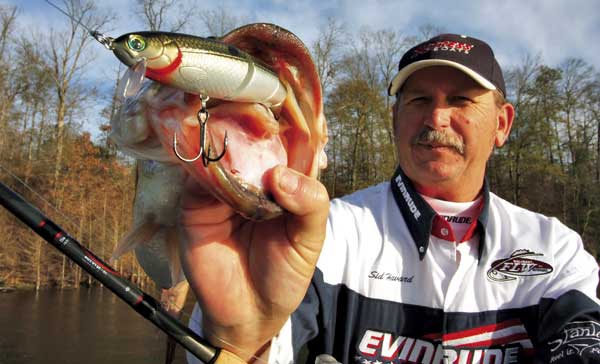
Extra-large swim baits are starting to deliver the goods in the Bayou State.
Have you ever seen one of those largemouth-bass mailboxes that some people have in front of their houses? Imagine taking one of those boxes and putting a couple treble hooks on the bottom of it.
Think that would be a little extreme?
Well, the end result of that little modification isn’t too far removed from what the baits look like that make up one the hottest new category of bass lures to come around in several years.
If you watch much bass fishing on television, you’ve no doubt seen anglers heaving these big lures as far as they can out into some pretty nondescript water. If that wasn’t enough to bore you into changing the channel, you also no doubt watched that same angler soon reeling in one of the biggest bass you’ve ever seen, then another, and another.
Like most decent fishing-show disciples, you probably then high-tailed it to your local tackle store to ask them if they had any swim baits because you couldn’t wait to try one during the big club tournament the next weekend.
If you were fortunate enough to find a swim bait or two — they were very rare in Louisiana for the longest time — the shear size of the thing made you think twice about it. The same guy who came up with the foot-long hot dog must have had a hand in the design of these things because it seems that the manufacturer had the crazy notion that if 6 inches was good, 12 inches had to be better.
Could a bass even get this thing in its mouth? If the tournament pros are to be believed, the simple answer is yes. Of course, they all throw them in big-bass factories like Lake Amistad and Sam Rayburn in Texas and Clear Lake out in California.
Surely these enormous baits wouldn’t work in little ol’ Louisiana, would they?
“Not so,” said Xpress Boats and Evinrude Motors pro Sid Havard from Simsboro. “Like most other bass anglers, I got interested in swim baits by watching the guys fish them in the major tournaments. I thought there had to be something to them, so I looked all over for them but couldn’t find any. I got a few in my hands after a little research on the internet. Man, those things were big, but I gave them a try, and I’m glad I did.”
Havard took his swim baits to Lake Claiborne near Homer just to get a feel for them in the water. Catching fish was the farthest thing from his mind. It just so happens that the fish had eating swim baits on their minds, and Havard caught a few big bass around isolated cypress trees up the Beaver Creek arm of the lake.
Randy Howell, a BASSMASTER Elite Series pro, got turned on to swim baits much the same way that Havard did. He saw other people whacking fish on them, and he realized he had to learn more about them so he could capitalize on this hot, new bite.
“You used to not see any swim baits laid out on anglers’ decks in the morning before a tournament,” said Howell. “Now you can hardly go by a boat without seeing at least one swim bait rod rigged up with one of those big baits. After Steve Kennedy won on a swim bait out at Clear Lake in California, it got everybody back east chomping at the bit to try them out.”
Before diving into the swim-bait fray head first, it’s important to understand the two different versions of swim baits. There are hard swim baits and there are soft swim baits.
The hard versions like the Strike King Kong and Fish Arrow Monster Jack feature a multi-jointed body with a diving bill on the front. The soft versions like the Optimum and Osprey baits feature baitfish profile bodies with swimming tails. Each has its place, but the soft versions are taking a stronger foothold in Louisiana than the hard baits.
Hard swim baits are designed to swim right below the surface, often as shallow as 2 or 3 inches. They also throw off a very distinct wake on the surface of the water that is invaluable to attracting actively feeding bass. Their giant treble hooks make them more of a choice for open water than for heavy cover.
Soft baits are a little more versatile in that you can fish them from the surface to the bottom. They are very similar to soft jerkbaits like the Slug-Go and Zoom Fluke in that they are fished on single hooks with the hook through the body and skin-hooked on the back of the bait. This makes them the obvious choice for swimming around heavy cover.
Havard mentioned that anglers can adjust the depth at which a soft swim bait will work by using a weighed hook like the Bait Jerker Hook produced by Falcon Lures. The heavier the weighted hook, the deeper you’ll be able to swim the lure.
“The key to fishing both kinds of swim baits is to not overwork them,” said Havard. “The action is built into these lures, and you’ll mess that action up if you try to reel it fast or jerk it around a lot. I use a high-speed reel, but I crank it really slow. I think a low-speed reel with something like a 4:1 gear ratio would be ideal because it would force you to fish it slowly.”
The reel isn’t the only equipment consideration involved when fishing these big lures. The simple act of casting these heavy baits takes a toll on rod, reel and line. Then the added stress of hooking and landing a lunker bass only adds to that toll.
Howell is satisfied with the performance of a 7-foot medium-heavy Quantum Tour Edition Signature Series rod matched with a Quantum Tour Edition PT reel spooled with 100 percent Trilene fluorocarbon line.
“Fluorocarbon line is right for me because it doesn’t have a lot of line stretch,” Howell said. “You’ve got to get a big hook to come through the plastic of a soft swim bait then into the lip of a big bass. Then you’ve got to have tough enough gear so that it won’t break down while you’re fighting that bass.”
Havard agreed with Howell, and while his choice of rod, reel and line is different, he selects it for the same reasons that Howell chose his.
“I’ve been using the new 8-foot Kistler Big Swim Bait Special rod,” he said. “Not only do you need a rod strong enough to handle casting these big baits, you also need that rod to be light enough to throw all day long if you have to, and that’s what this rod achieves. And I don’t use anything less than 20-pound-test Gamma or Big Game mono on the hard swim baits, while I tend to stick with the braided line on the soft swim baits.”
Just rigging up with the proper gear and tying on a swim bait isn’t enough to get you bit in Louisiana, though. While a swim bait is subject to catch a big bass just about any time of the year, Havard believes there are certain situations for which anglers should look when throwing swim baits.
Even though he didn’t get to fish swim baits in Louisiana during last year’s spawn — he didn’t find the lures until the spawn was over — he can hardly contain his excitement about throwing them to shallow spawning bass.
“The hard and soft swim baits are going to be killer during the spawn,” said Havard. “The hard baits run so shallow that you should be able to work them around and through the bushes much like you were fishing a Mann’s Baby 1-Minus. What I’m really looking forward to doing is bringing a bream-colored soft swim bait past a bass that is guarding fry on a nest.”
What Havard has done so far with the baits in Louisiana is catch fish on them at Claiborne, Caddo Lake and Lake Bistineau. The primary swim-bait pattern has been the same on each of the three lakes. His best success has come when he’s found a couple big gizzard shad swimming around isolated cypress trees during the summer.
This is the kind of situation in Louisiana that is tailor-made for fishing swim baits. Big bass love to get around cover so far off by itself that nobody takes the time to bother fishing it.
Big bass love to eat big swim baits because they are such a lumbering lure that represents and big meal that’s easy to catch. Throw that big swim bait by that isolated tree, and you’re going to catch that big bass.
The other killer situation for throwing swim baits in Louisiana is around grass beds. Havard believes the ideal time to fish them around the grass is before it has matted out on the surface.
“You can find grass growing just below the surface in the north end of lakes during the spring,” he explained. “Toledo Bend, Black Lake, Claiborne, D’Arbonne — they all have grass now. And once that grass mats out on the surface, you can throw the soft swim baits in the holes by reeling it up to the hole and killing it.”
Hooking bass on these big baits is often an exercise in frustration. The best advice that Havard and Howell had was to wait until you feel the weight of the fish before you set the hook. It’s very similar to fishing a Zara Spook or a Stanley Ribbit in that the best thing to do is keep reeling until you feel the rod load up, then put the hammer down.
Make no mistake about it, though. These baits are going to take some getting used to before you become efficient with them. Much like fishing a jig, they take the mindset that you’re only looking to get five or six bites a day, but you’re giving up quantity for what you hope to catch in quality.
“I’ve been laughed at by anglers who thought I was crazy for having one of these baits tied on,” Havard said. “They were laughing at what they saw on the surface of the deck, though. They didn’t know about all those big bass swimming around below the deck in my livewell.”
Another point Havard made about swim baits is that while you may see anglers on television throwing them out in the middle of open water, there’s more to that situation than you can see.
“What you can’t see on camera are all those trees below the surface,” he said. “They may be in 50-foot water, but they’re fishing over trees that top out about 10 feet below the surface. They’re drawing the fish up out of those trees much like anglers on Table Rock in Missouri do when fishing the jointed Cotton Cordell Redfin over the tops of those cedar trees.”
If you’re interested in expanding your bass fishing repertoire this year, tie on a couple swim baits, and leave everything else at home. Throw them around shallow cover this spring until you gain enough confidence that they’ll catch fish.
“Take them to lakes around your house that aren’t known for big fish,” Howell suggested. “You just might be surprised to learn what size fish live in that lake. And if you don’t catch fish on them, keep going to smaller and smaller swim baits until you find one that those fish like. Eventually you’ll find one that works.”
A word of warning is in order, though. You just might gain enough confidence in swim baits that you have to go out and buy another tackle box. And if you really want to catch a big fish, just make sure that tackle box is big enough to hold your neighbor’s mail box.
